Butterfly: Powerful Ancient Symbol Of Beauty, Transformation, Hope, Rebirth And Happiness Featured In Myths And Legends
A. Sutherland - AncientPages.com - Insects have always accompanied humans; some of them have gained a special place in culture and mythology. A butterfly has deep roots in the early beliefs of ancient people around the world, and many myths and legends feature this fantastic insect.
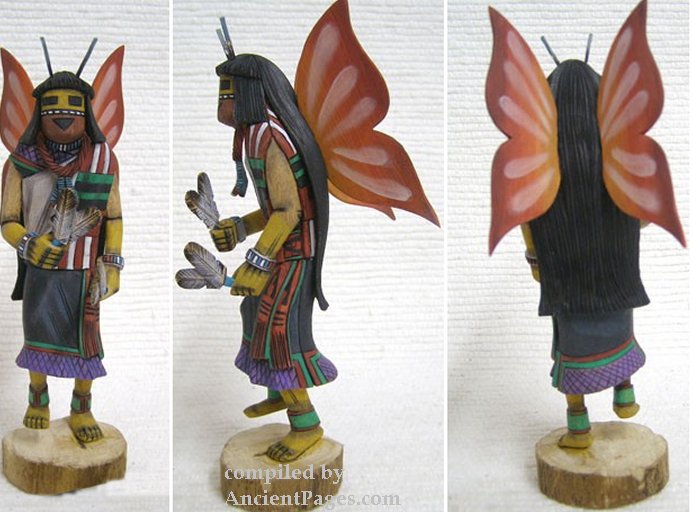 Native American Hopi Carved Butterfly Maiden Kachina Doll. Credit: kachinahouse
Native American Hopi Carved Butterfly Maiden Kachina Doll. Credit: kachinahouse
A good example can be the butterflies, one of the most beautiful insects that symbolize the day and female beauty.
The butterfly has been a symbol in almost every culture of transformation and rebirth. The butterfly experience many changes, starting its life in one form and ends in another. Ancient people (and perhaps also modern ones) have long believed that our souls transform. The ancient Romans believed that a butterfly symbolized the soul, and butterflies often adorned old tombstones.
Importance Of Butterfly Among Native Americans
For many Native American tribes, the appearance of a butterfly announces beautiful weather and good luck. However, butterflies play a variety of other roles in folktales of these people depending on the tribe. Sometimes, butterflies represent balance and change; other folktales emphasize their beauty, vanity, and playful behavior. Some Native America tribes had taboos against killing these insects. Likewise, among ancient Irish beliefs, there was one saying that in white butterflies dwelled the souls of young children.
The killing of such a butterfly had significant and very negative consequences.
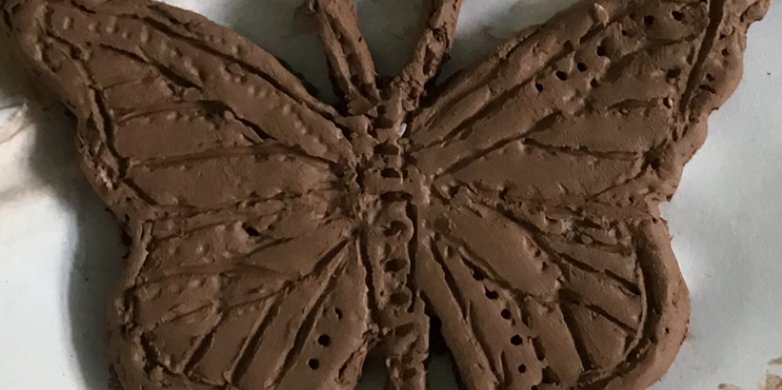 For the Greeks, the butterfly was the symbol of the soul or psyche. source
For the Greeks, the butterfly was the symbol of the soul or psyche. source
Blackfoot people of Saskatchewan, Alberta, and British Columbia, and the U.S. state of Montana, strongly associate butterflies with sleep and dreaming, and butterfly designs were used to decorate cradleboards and other children's objects to help them sleep and experience pleasant dreams.
For the Aztecs, the butterfly was associated with women who had died in childbirth. Such women were honored with the same praise as the Aztec warriors who lost their lives in combat. The monarch butterfly represented the souls of deceased children who return to earth. The Aztecs saw the image of a human face in the insect’s wing motif, and in times of Teotihuacan's greatness, seals and headdresses were adorned with it.
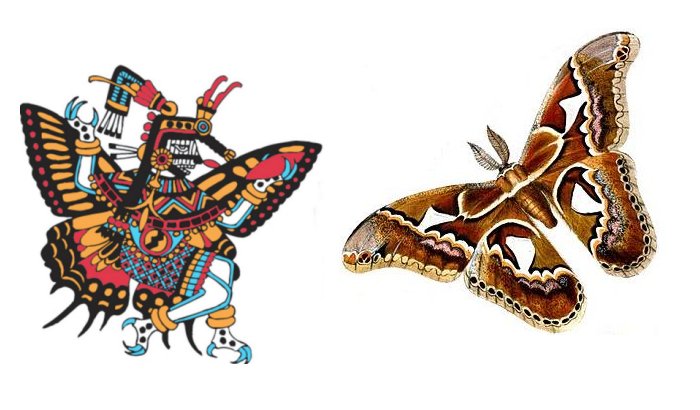 In Aztec mythology, Itzpapalotl ("Obsidian Butterfly") was a skeletal warrior goddess who ruled over the world of Tamoanchan, the paradise of victims of infant mortality and the place identified as where humans were created. source source2
In Aztec mythology, Itzpapalotl ("Obsidian Butterfly") was a skeletal warrior goddess who ruled over the world of Tamoanchan, the paradise of victims of infant mortality and the place identified as where humans were created. source source2
Butterflies were also associated with fire; their swarming together resembles a dance giving associations with the flames of a bonfire.
Hopi And 'Butterfly Dance'
Irish folklore attributes butterflies the ability to penetrate between worlds, and the Indians of South America believed that if someone could count the spots on the wings of the most numerous variety of butterflies there, they would find out how much money they would make in their lives.
Among the Hopi in North America, the butterfly is one of the animals of the creator, and so they perform beautiful 'Butterfly Dance' in honor of the butterfly Kachina. The Butterfly Maiden, called Palhik Mana, appears in August when butterflies appear in Arizona. The ceremony is held as a thanksgiving for the corn harvest, and the maidens represent the butterflies that pollinate the corn, helping to bring the crop.
Butterflies Are The Returning Souls Of The Dead
For the Maori, however, the butterfly is a symbol of longevity and immortality while the aborigines of Australia believe that butterflies are the returning souls of the dead.
For the Greeks, the butterfly was the symbol of the soul or psyche. The story of the soul's transformation from human to immortal status is told in the tale of Eros and Psyche.
For the Chinese, the butterfly is the emblem of immortality, joy, and leisure. Its depictions with the plum mean longevity; when it is illustrated with the chrysanthemum plant (know in China since at least 500 BC) it portrays beauty in old age. The butterfly also means a young man in love; however, if the woman he loves dies, she may be represented coming out of her grave as a butterfly.
In Japan, ancient people had both positive and negative associations with the butterfly, which symbolized a dishonest lover, a vain woman, or a geisha who stays with no husband but is available to man after man. This insect was often viewed as a bad omen, but it also had a positive meaning: two butterflies dancing together was a sign of happy love and happiness in marriage.
Butterfly – Christian Symbol Of Resurrection Of All Men
In Christian iconography, the butterfly is sometimes shown in paintings of Christ Child and the Virgin, particularly in the Child's hand, and symbolizes not only Jesus' resurrection but also the resurrection of all men.
It has clear associations with the butterfly's three stages of life: the caterpillar, the chrysalis, and the butterfly. At the same time, these three stages mean human life, death, and resurrection.
Written by - A. Sutherland - AncientPages.com Senior Staff Writer
Copyright © AncientPages.com All rights reserved. This material may not be published, broadcast, rewritten or redistributed in whole or part without the express written permission of AncientPages.com
Expand for referencesReferences:
Ferguson G. Signs and Symbols in Christian Art
Matthews, Caitlin. The Element Encyclopedia of Magical Creatures
Lake-Thom B. Spirits of the Earth
More From Ancient Pages
-
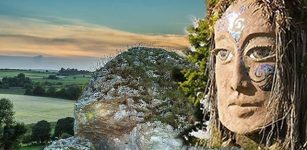 Eriu: Powerful Irish Goddess And Sacred Uisneach Hill Where She And God Lugh Are Buried
Celtic Mythology | Feb 15, 2019
Eriu: Powerful Irish Goddess And Sacred Uisneach Hill Where She And God Lugh Are Buried
Celtic Mythology | Feb 15, 2019 -
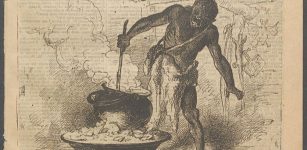 Obeah: Who Were The Feared Shadow Killers Of Jamaica?
Ancient Traditions And Customs | Sep 24, 2018
Obeah: Who Were The Feared Shadow Killers Of Jamaica?
Ancient Traditions And Customs | Sep 24, 2018 -
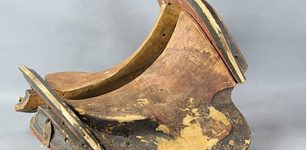 World’s Oldest Known ‘True’ Saddle Discovered In East Asia
Archaeology | Dec 11, 2023
World’s Oldest Known ‘True’ Saddle Discovered In East Asia
Archaeology | Dec 11, 2023 -
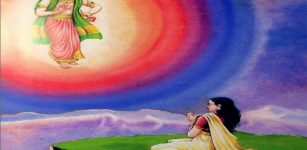 Aditi – Primeval Hindu Goddess Who Is Source Of All Living Beings
Featured Stories | Apr 3, 2021
Aditi – Primeval Hindu Goddess Who Is Source Of All Living Beings
Featured Stories | Apr 3, 2021 -
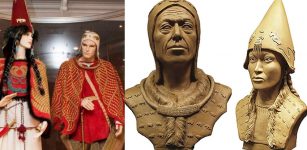 Stunning Facial Reconstruction Of ‘Siberian Tutankhamun’ And His ‘Queen’ Who Died 2,600 Years Ago
Archaeology | Jan 12, 2021
Stunning Facial Reconstruction Of ‘Siberian Tutankhamun’ And His ‘Queen’ Who Died 2,600 Years Ago
Archaeology | Jan 12, 2021 -
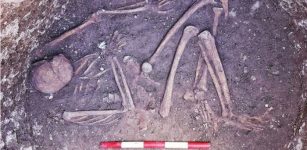 Rare Iron Age Crouch Burial Discovered At The Margate Caves Site In Kent, UK
Archaeology | Mar 8, 2018
Rare Iron Age Crouch Burial Discovered At The Margate Caves Site In Kent, UK
Archaeology | Mar 8, 2018 -
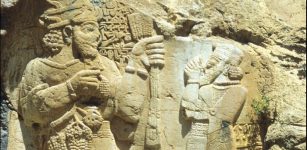 Ivriz Relief: 3,000-Year-Old Hittite Relief – Oldest Known Symbol Of Agricultural Fertility In History
Artifacts | Jun 13, 2019
Ivriz Relief: 3,000-Year-Old Hittite Relief – Oldest Known Symbol Of Agricultural Fertility In History
Artifacts | Jun 13, 2019 -
 Ancient Knowledge Of Other Worlds And An ‘Impossible’ Being That Shouldn’t Exist
Featured Stories | May 6, 2020
Ancient Knowledge Of Other Worlds And An ‘Impossible’ Being That Shouldn’t Exist
Featured Stories | May 6, 2020 -
 1,800-Year-Old Buddhist Stupa And Relics Discovered Near Bazira, The Ancient City Of Alexander The Great
Archaeology | Feb 11, 2022
1,800-Year-Old Buddhist Stupa And Relics Discovered Near Bazira, The Ancient City Of Alexander The Great
Archaeology | Feb 11, 2022 -
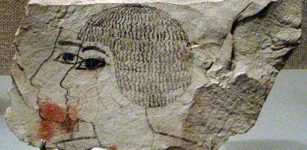 Tomb Of Senenmut And Earliest Known Star Map In Ancient Egypt
Civilizations | Nov 17, 2016
Tomb Of Senenmut And Earliest Known Star Map In Ancient Egypt
Civilizations | Nov 17, 2016 -
 On This Day In History: Great Siege of Malta: Ottoman Forces Made Attempt To Conquer Malta And Failed – On May 18, 1565
News | May 18, 2016
On This Day In History: Great Siege of Malta: Ottoman Forces Made Attempt To Conquer Malta And Failed – On May 18, 1565
News | May 18, 2016 -
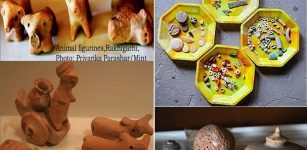 Early Harappan Cultures Can Solve Mysteries Of Several Lost Cities Of Indus Valley Civilization
Artifacts | May 30, 2019
Early Harappan Cultures Can Solve Mysteries Of Several Lost Cities Of Indus Valley Civilization
Artifacts | May 30, 2019 -
 America’s Native Population Arises From A Single Wave Of Asian Migration – Dental Anthropologists Say
Archaeology | Dec 19, 2023
America’s Native Population Arises From A Single Wave Of Asian Migration – Dental Anthropologists Say
Archaeology | Dec 19, 2023 -
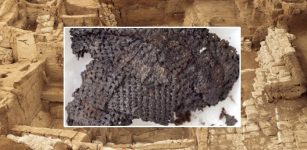 This Is One Of The Oldest Pieces Of Cloth In The World And It’s Made Of Bast Fibers!
Featured Stories | Aug 26, 2023
This Is One Of The Oldest Pieces Of Cloth In The World And It’s Made Of Bast Fibers!
Featured Stories | Aug 26, 2023 -
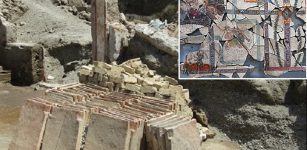 Pompeii Region IX: Roman Advanced Construction Techniques In New Light
Archaeology | Mar 27, 2024
Pompeii Region IX: Roman Advanced Construction Techniques In New Light
Archaeology | Mar 27, 2024 -
 Glorious And Scary Orava Castle – Realms Of Nosferatu And A Historical Landmark Of Slovakia
Featured Stories | Jan 24, 2020
Glorious And Scary Orava Castle – Realms Of Nosferatu And A Historical Landmark Of Slovakia
Featured Stories | Jan 24, 2020 -
 On This Day In History: William Laud Archbishop Of Canterbury Beheaded – On Jan 10, 1645
News | Jan 10, 2017
On This Day In History: William Laud Archbishop Of Canterbury Beheaded – On Jan 10, 1645
News | Jan 10, 2017 -
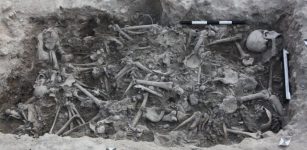 DNA Of Nine 13th Century Crusaders Provides A Glimpse Into Soldiers’ Life And Death
Archaeology | Apr 22, 2019
DNA Of Nine 13th Century Crusaders Provides A Glimpse Into Soldiers’ Life And Death
Archaeology | Apr 22, 2019 -
 Mystery Of An Edinburgh Crypt – Secrets Of Warriors Of Dark Ages In Scotland – Revealed
Archaeology | Oct 3, 2015
Mystery Of An Edinburgh Crypt – Secrets Of Warriors Of Dark Ages In Scotland – Revealed
Archaeology | Oct 3, 2015 -
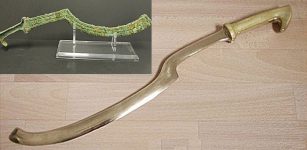 Khopesh Sword – Symbolic Weapon Of The Pharaohs And Emblem OF Egyptian Deities
Artifacts | May 27, 2021
Khopesh Sword – Symbolic Weapon Of The Pharaohs And Emblem OF Egyptian Deities
Artifacts | May 27, 2021
